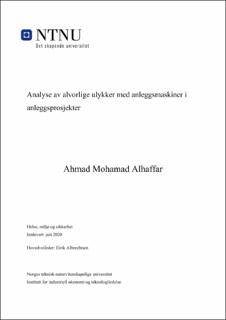| dc.contributor.advisor | Albrechtsen, Eirik | |
| dc.contributor.author | Alhaffar, Ahmad Mohamad | |
| dc.date.accessioned | 2021-09-14T17:07:28Z | |
| dc.date.available | 2021-09-14T17:07:28Z | |
| dc.date.issued | 2020 | |
| dc.identifier | no.ntnu:inspera:58793592:58858383 | |
| dc.identifier.uri | https://hdl.handle.net/11250/2776950 | |
| dc.description.abstract | Formålet med denne oppgaven var å gjøre en analyse av alvorlige ulykker med anleggsmaskiner og finne årsakene til disse, slik at man kan gir anbefalinger for å redusere og hindrer ulykker. Bygg- og anleggsbransjen er kompleks, og har høy risiko. Utfordringer i sikkerhet og statistikk fra Arbeidstilsynet viser at denne bransjen er spesielt utsatt for arbeidsskader og dødsulykker sammenlignet med andre bransjer. Bakgrunnen for disse ulykkene har flere årsaker, som vil bli funnet frem til og diskutert i denne oppgaven.
Gjennom analyse av databaser og intervju ble det funnet behov for å øke sikkerhet og barriere ved å forbedre opplæring med anleggsmaskiner, lage sikkerhetsplaner som inkluderer tidspress som ulykkesårsak, og bruker Arbeidstilsynets visjon som rammeverk for arbeidet. Sikkerhetskrav skal være et verktøy i sikkerhetsstyringen og planleggingen, og hvis disse kravene brytes, er det ingen poeng i å ha krav. Sikkerhet er i denne oppgaven er avgrenset til å analysere arbeidsaktivitet, og innebefatter å unngå hendelser som død, kritiske skader og kuttskader.
Det ble sett på ulykkesrapporter fra Arbeidstilsynet (2019a) og laget en ulykkesdatabase for å analysere rapportene. Det ble også utført kvalitative forskningsintervju med eksperter i anleggsbransjen for å undersøke oppgavens formål. Seks intervjuobjekter ble intervjuet, fordelt på et prosjektleder, en fagarbeider, to HMS-rådgivere og to regionale verneombud. Intervjuene ble gjennomført ved å operasjonalisere oppgavens formål inn i seks avvik: menneskelig feil, teknisk feil, personer i faresone, manglende informasjonsflyt, bevegelse av anleggsmaskiner, og risikovurdering.
Oppgaven viser at sikkerhet kan økes ved fokusere på detaljer og lage barriere for å fylle gapene i sikkerhetssystem gjennom arbeid. Blant annet at konsekvensene knyttet til sikkerhetsutfordringer er umiddelbare og mindre kontrollerbare, samt at de oppleves som mer ukjent og mer alvorlige sammenlignet med arbeidsmiljøfaktorene. Den viktigste faktoren er å øke risikoforståelse for arbeidstakere og forsterke sikkerhetskultur hos dem. | |
| dc.description.abstract | The purpose of this assignment was to do an analysis of serious accidents with construction equipment and find the causes of these, so that recommendations can be made to reduce and prevent accidents. The building and construction industry is complex and has a high risk. Challenges in safety and statistics from the Norwegian Labor Inspection Authority show that this industry is particularly vulnerable to occupational injuries and fatalities compared with other industries. The causes of these accidents have several causes, which will be found and discussed in this paper.
Through analysis of databases and interviews, a need was found to increase safety and barrier by improving training with construction equipment, making safety plans that include time pressure as a cause of accident, and using the Labor Inspection Authority's vision as a framework for the work. Security requirements should be a tool in security management and planning, and if these requirements are breached, there is no point in having claims. Safety in this task is limited to analyzing work activity, and involves avoiding incidents such as death, critical injuries and cuts.
Accident reports from the Norwegian Labor Inspection Authority (2019a) were looked at and an accident database was created to analyze the reports. Qualitative research interviews were also conducted with construction industry experts to investigate the purpose of the thesis. Six interview items were interviewed, distributed among a project manager, a specialist worker, two HSE advisers and two regional safety representatives. The interviews were conducted by operationalizing the purpose of the task into six nonconformities: human error, technical error, people at risk, lack of information flow, movement of construction equipment, and risk assessment.
The thesis shows that safety can be increased by focusing on details and creating a barrier to fill the gaps in the security system through work. Among other things, the consequences associated with security challenges are immediate and less controllable, and that they are perceived as more unknown and more serious compared to the work environment factors. The most important factor is to increase risk awareness for employees and to strengthen their safety culture. | |
| dc.language | | |
| dc.publisher | NTNU | |
| dc.title | Analyse av alvorlige ulykker med anleggsmaskiner i anleggsprosjekter | |
| dc.type | Master thesis | |
